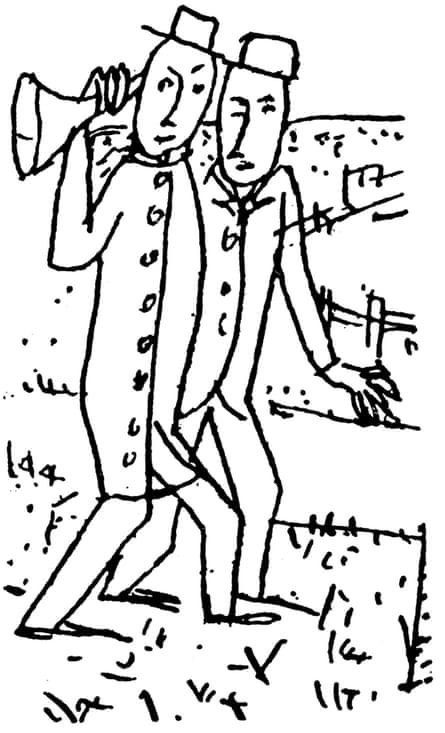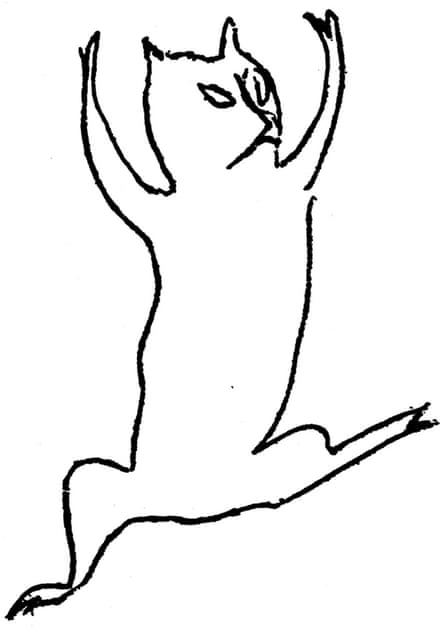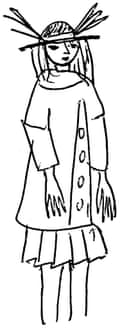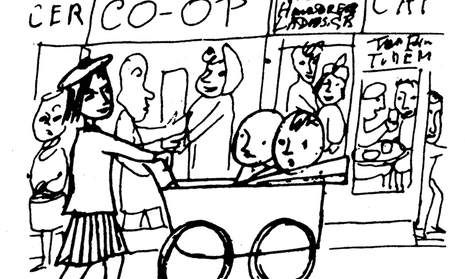Who or what is Stevie Smith, Ogden Nash once pondered. The poet and novelist who slinked the suburbs of north London has often proved a riddle. Her most famous poem, “Not Waving but Drowning”, turns on a fatal misunderstanding, but she is good at pulling the wool over our eyes. She once characterised writers as shrewd, and the apparently careless lollop of her lines belies an astute technician.
A constant in Smith’s career was her determination to include drawings alongside her poems, yet most were omitted from posthumous editions. When I was approached by Faber to edit a new Collected, it seemed a chance to put this right. Smith’s poetry specialises in uncanny objects – plaster busts of dead mothers sitting on pianos, hats of surreal proportions, gas fires worthy of friendship, and toxic mushrooms. Her drawings are similarly disorientating. Sketches of enigmatic women look out from the page, like readers who have got there first but are unwilling to give up their secrets to us. Like her poetry, her drawings have eclectic starting points. Some are inspired by the epigrammatic underlines of Goya or the sketches of Georg Grosz, while others skirt closer to Edward Lear. While a few appear to be illustrations to the poems they accompany, many were added to her poems at proof stage or substituted for an apparently unrelated doodle, deliberately unsettling how we might understand a poem’s speaker, tone or addressee. They are as likely to put us on our guard as provide relief.

They make editors guarded, too, about claiming to be definitive. The finality of the printed page bothered Smith, and poetry performances in the 1960s often found her rewriting a line or stanza for a particular audience. Pruning her own work sometimes defeated her, and she called on Laurie Lee to help her select the poems for Not Waving But Drowning. “Too light?” is a common query on the drafts she sends him. Many missed book publication for more prosaic reasons; the only copy of her 1961 poem “The Holiday” was with a US magazine editor as she prepared her first Selected Poems the following year. It has been a pleasure to return these poems to print.
Preparing a volume for publication found Smith at her most prolific. Planned poems were dropped for new works scribbled on the back of proofs. Both “A Fiend” and “Le Paquebot” were sent to James Laughlin at New Directions for the US edition of Selected Poems in 1963, too late for inclusion. “A Fiend” tempers “playtime” with a “frown”; like many subjects in Smith’s poems, the bird makes a bid for freedom by embracing death. The poem’s half-rhymes shadow-box each other, before “fiend” and “friend” finally strike up an uneasy alliance. “Le Paquebot” is a winking letter-poem. Smith’s schoolgirl French makes a bumpy voyage between languages as she imagines her uneven transatlantic reception.
Dating Smith’s unpublished poems can be difficult; her first collection includes a poem called “Progression”, and some of her greatest admirers questioned whether her work really had any. Smith’s own manuscript copies suggest both “The Old Soul” and “She got up and went away” were written in the early 1960s. The first of these shows a characteristic disdain for apocalyptic thinking, though the speaker’s sage advice not to “ponder or too fondly hope” goes unheeded. Meanwhile, “She got up and went away” worries away at a moment of decisive action. Like her poem “Thoughts about the Person from Porlock”, it shows Smith’s abiding interest in how we justify our decisions to the world.
How much of her work would Smith want collected? She produced more poems and drawings than can be contained in one book. There is little sense from her own criticism that any poet is served by having only one title in print. Her 1958 book of drawings and captions for Gabberbochus Press was entitled Some Are More Human Than Others and, of her own poems, she might be happy to say some are more collected than others.
- The Collected Poems and Drawings of Stevie Smith (Faber & Faber, £35) is published on 1 October. To order a copy for £25, go to bookshop.theguardian.com or call 0330 333 6846. Free UK p&p over £10, online orders only. Phone orders min. p&p of £1.99.
The Old Soul
When all was young the Race began
And life was fair in Eden’s span
But oh the way and oh the way
was long that then began.
Oh boys and girls whose laughing curls
The ancient winds well practised toss
I’m very glad the way we tread
is not so long as it once was.
Then dance with me and don’t mope
Or ponder or too fondly hope
But oh I hear and oh I see
That oh they will not dance with me.

A Fiend
Little bird of brightest laugh
Joying on the human hearth
In thy playtime lurks a frown
I do not think you are at home.
Bird of laughter, bird of wrath
Dost thou, dost thou see the path?
The door is ope, the skies are gray,
Up, bird, and run away.
He was a bird of highest mettles,
He left the hearth, he left the people,
They said a fiend had called him off
And how he lives in the sky so rough,
They said, Why should our little Dear
Have left us for the open air?
The skies are gray and the wind blows hard,
He would be better in our yard.
Fools, thy bird flies free and high
His laughter is no longer sly
As on earth it used to be,
Now he laughs as one who is free.
Free, free, I heard him pipe
As the wild winds carried him out of life,
And still they say it was a fiend
That tempted him and not a friend.

Le Paquebot
C’est la, la, la,
Le Paquebot a moi,
Dites-moi Goodbye,
Parce-que je go far.

She got up and went away
She got up and went away
Should she not have? Not have what?
Got up and gone away.
Yes, I think she should have
Because it was getting darker.
Getting what? Darker. Well,
There was still some
Day left when she went away, well,
Enough to see the way.
And it was the last time she would have been able. . .
Able? . . . to get up and go away.
It was the last time the very last time for
After that she could not
Have got up and gone away any more.

Comments (…)
Sign in or create your Guardian account to join the discussion